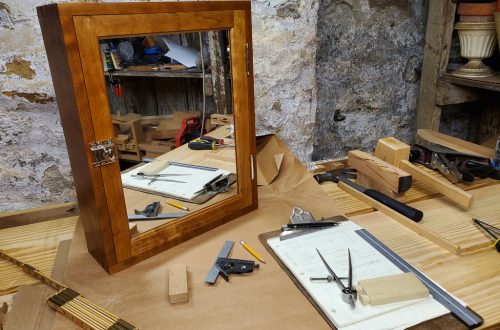Urban Gardening, Part I: Where to Plant?
 Hello everyone. Jenny and I have wanted to start a garden here at the house for quite a while. Shortly before I met her, I had a small garden in the back yard in an area that was apparently a small garden or flower bed at one time. My Dad and I uncovered it one day while working in the back yard. There was a small indentation along the sidewalk. We dug a little and uncovered a rectangular area along the sidewalk bordered with white porcelain-sided bricks. He brought his rototiller down and tilled it for me, and then I planted a small garden there with some cucumbers, peppers, tomatoes and herbs. It grew quite well, but the bottom of the plants ended up sustaining some heavy damage from grubs and slugs. While further proving how wonderfully fertile our soil is down here (thanks to this being a farm for many years before getting subdivided in the late 1800’s), the ground insect damage shortened the production lifespan of most of the plants. I did get some wonderful produce that year, but did not re-plant in subsequent years. I ran out of time, as my job started to take more and more of it, and I didn’t have enough time to think about how to solve the bug problem.
Hello everyone. Jenny and I have wanted to start a garden here at the house for quite a while. Shortly before I met her, I had a small garden in the back yard in an area that was apparently a small garden or flower bed at one time. My Dad and I uncovered it one day while working in the back yard. There was a small indentation along the sidewalk. We dug a little and uncovered a rectangular area along the sidewalk bordered with white porcelain-sided bricks. He brought his rototiller down and tilled it for me, and then I planted a small garden there with some cucumbers, peppers, tomatoes and herbs. It grew quite well, but the bottom of the plants ended up sustaining some heavy damage from grubs and slugs. While further proving how wonderfully fertile our soil is down here (thanks to this being a farm for many years before getting subdivided in the late 1800’s), the ground insect damage shortened the production lifespan of most of the plants. I did get some wonderful produce that year, but did not re-plant in subsequent years. I ran out of time, as my job started to take more and more of it, and I didn’t have enough time to think about how to solve the bug problem.
As the years passed, I recalled my Mom’s garden back at home in Cooperstown, before we moved here to New Kensington. She always had raised beds in the garden, with little pathways going between them. I wished I had more land here, but our small urban yard was not a good fit for the kind of raised-bed gardening I remembered from my childhood. Instead of growing at home, Jenny and I began purchased shares of a CSA for a few years. We enjoyed that, but were ending up getting things that we couldn’t really use well, and so eventually we dropped the CSA shares and would shop more heavily at farmer’s markets and local fruit and veggie stands.
Last year, my Mom got a book called “Lasagna Gardening” or something along those lines. The book itself was pretty interesting, but what was most intriguing were the descriptions of how to have productive gardens in small spaces. My Mom was looking for an easier way to manage her garden, and found in the book some basic plans for 4′ x 4′ raised-bed planters. These were designed to sit on existing soil, using newspaper and layers of compost and soil to build a fertile soil mix. They were perfect for her garden area. While I looked at them and read some of the book, I realized that this might be a way to solve our garden issues, too.
 So after getting some of the measurements from my Dad, I began to adapt the planters to our uses. I still wanted the 4′ x 4′ footprint, but I thought I had some better ideas on how to build them a little bit more easily. Unfortunately, there was a bit of a miscommunication about dimensions, and the plans I drew-up had the single-layer planters with 12″ high walls, and the double-layer planters with 12″ high outside walls and an inside section with 24″ high walls. It turns out that the walls were supposed to be 6″ high on the outside, and 12″ high for the inside. The end result is that I needed a lot more soil for the basic first fill, but the upshot is that I could grow things like onions and even potatoes if I wanted, since I had space for a deeper root system. An indirect benefit is that this will probably also help to keep the lower parts of plants further away from ground-dwelling animals.
So after getting some of the measurements from my Dad, I began to adapt the planters to our uses. I still wanted the 4′ x 4′ footprint, but I thought I had some better ideas on how to build them a little bit more easily. Unfortunately, there was a bit of a miscommunication about dimensions, and the plans I drew-up had the single-layer planters with 12″ high walls, and the double-layer planters with 12″ high outside walls and an inside section with 24″ high walls. It turns out that the walls were supposed to be 6″ high on the outside, and 12″ high for the inside. The end result is that I needed a lot more soil for the basic first fill, but the upshot is that I could grow things like onions and even potatoes if I wanted, since I had space for a deeper root system. An indirect benefit is that this will probably also help to keep the lower parts of plants further away from ground-dwelling animals.
I took a nice weekend day, and built our two planters. I built one single-level one, and one two-level one. The two-level one is designed to have a netting support come up from the center, to support climbing plants like beans. To assemble both, I ripped and crosscut standard 2×4’s into square posts for the corners. For the single-level planter, I cut 12″ long posts, one for each corner. For the two-level planter, I cut four 12″ long posts for the four outer corners, and four 24″ long posts for the inner corners of the higher level. 48″ long 1×6 boards were glued and nailed to the posts with a pneumatic nailer (wow this made the job go really fast).  For the inner box, I built it as a separate box on the 24″ long posts, which then nested inside the outer box. Once the two boxes were assembled, I put the inner box upside-down on the ground, and then lifted the outer box on top of it. I then quickly checked that the assembly was centered and square, and then nailed through the outer side of the outer box into the posts of the inner box (photo right). As you can see in the photo, the posts were a little long, as a 1×6 isn’t really 6″ wide. I did this on purpose, to provide some “feet” to help anchor the box in place, and to help avoid something I was worried about–the bottom of the boxes bowing-out due to the weight of the dirt inside and the downward pressure on the ground if the boxes rested solely on the walls. This may have been an imaginary problem, but eh, they’re done and on the ground. 🙂
For the inner box, I built it as a separate box on the 24″ long posts, which then nested inside the outer box. Once the two boxes were assembled, I put the inner box upside-down on the ground, and then lifted the outer box on top of it. I then quickly checked that the assembly was centered and square, and then nailed through the outer side of the outer box into the posts of the inner box (photo right). As you can see in the photo, the posts were a little long, as a 1×6 isn’t really 6″ wide. I did this on purpose, to provide some “feet” to help anchor the box in place, and to help avoid something I was worried about–the bottom of the boxes bowing-out due to the weight of the dirt inside and the downward pressure on the ground if the boxes rested solely on the walls. This may have been an imaginary problem, but eh, they’re done and on the ground. 🙂
 The single-level planter was exactly the same construction for the outside, but it didn’t have the inner section added. After being built, these were moved into position, and newspaper was placed under them to cover (and eventually smother) the grass. The paper was then covered with some compost, and then a 50/50 mix of topsoil and compost filled the rest of the boxes. I saved about an inch at the top of each one (after settling) to give me some room to add compost at the end of the growing season this year. In all, these planters took about a yard and a half of soil to fill. That was a lot of wheelbarrows.
The single-level planter was exactly the same construction for the outside, but it didn’t have the inner section added. After being built, these were moved into position, and newspaper was placed under them to cover (and eventually smother) the grass. The paper was then covered with some compost, and then a 50/50 mix of topsoil and compost filled the rest of the boxes. I saved about an inch at the top of each one (after settling) to give me some room to add compost at the end of the growing season this year. In all, these planters took about a yard and a half of soil to fill. That was a lot of wheelbarrows.
Now that these are in place, filled, and planted, we are excited to have a working garden again. There’s still a lot of care that we’ll have to provide, of course, and we may yet have to place slug traps, but right now we’ve got a selection of really healthy plants growing quite well. One of the advantages of these sorts of planters is that one can force some more produce by using more compact plantings. I wasn’t sure how well that would work, but my Mom had great luck with the technique last year, and our plants look really healthy so far.
We’re back to having a garden, and it looks like it will be a high-producing garden in a small space. Hence the title of this blog post. We’re urban gardeners. We live in a city neighborhood, with a city lot. We’re lucky to have a nice-sized lot. As I look at how these work, though, I realize that these could also have worked quite well in my lot when I lived in the Mt. Washington neighborhood in Pittsburgh, and could probably work in a lot of other city neighborhood lots, too. I hope to have several other posts this summer following our little garden’s progress. Next up is a post about the planting process and how we planned our garden planting. Until then, go grow something….
[edit: I forgot to add that I have some simple CAD drawings of the planters that I was working on for this post, but I am not a super-skilled AutoCAD user yet, so I was encountering some challenges getting them formatted nicely for posting here. I’m happy to share those drawings in a slightly-less-than-professional way if you would like them–just contact me.


